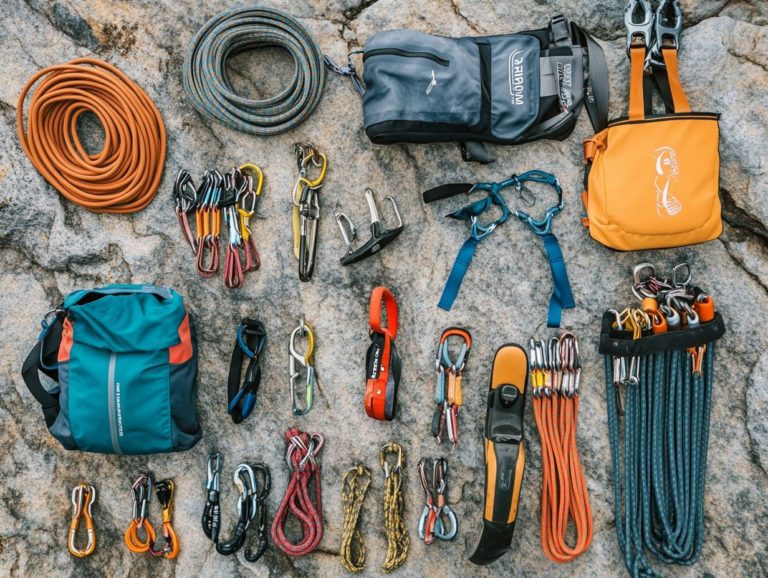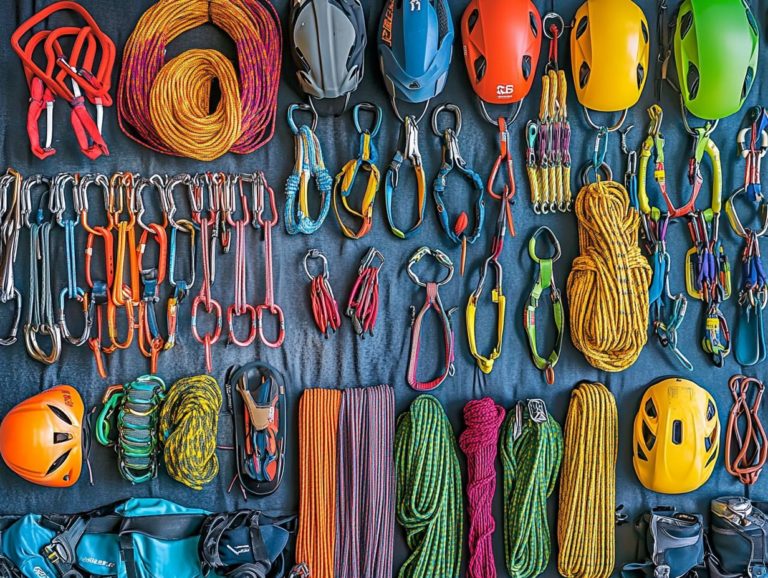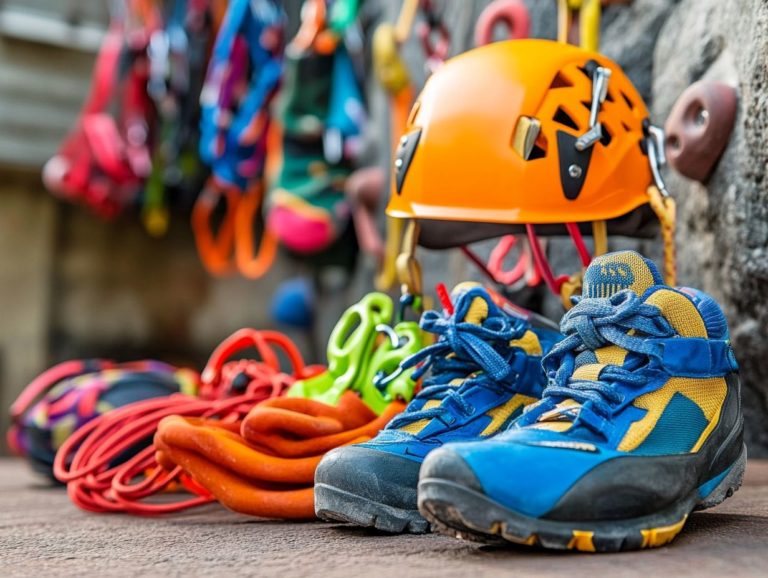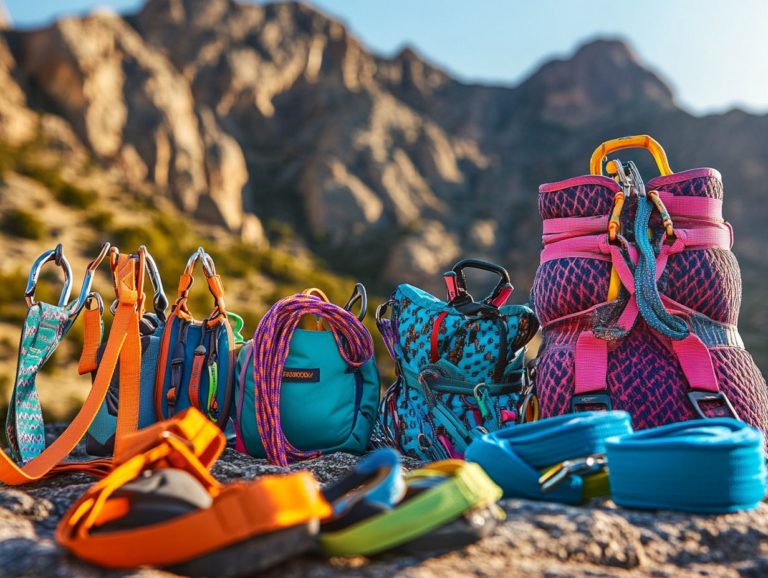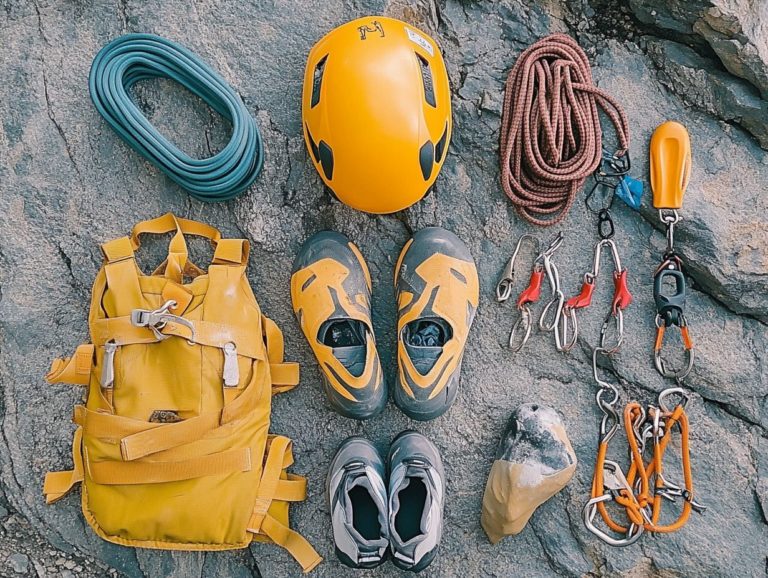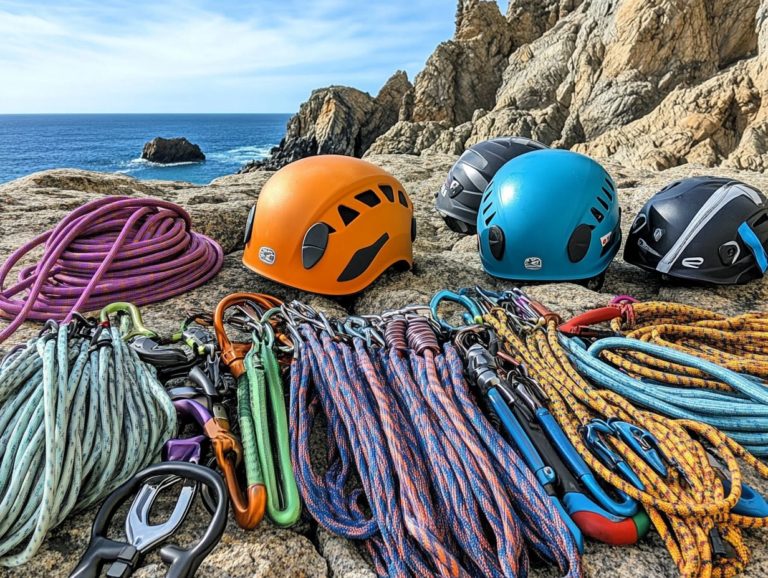Best Climbing Gear for Traveling Climbers
Preparing for a climbing adventure? Whether you re a seasoned pro or just starting this thrilling journey, the right gear is essential. It ensures a safe and enjoyable adventure.
This article dives into the essential climbing equipment every traveling climber should pack. From climbing shoes and harnesses to often-overlooked first aid kits, you ll cover everything you need to gear up effectively.
Discover tips on maintaining your gear and avoiding common packing pitfalls. Are you ready to conquer new heights?
Contents
- Key Takeaways:
- 1. Climbing Shoes
- 2. Chalk Bag
- 3. Harness
- 4. Belay Device
- 5. Quickdraws
- 6. Rope
- 7. Climbing Helmet
- 8. Carabiners
- 9. Climbing Backpack
- 10. Climbing Pants
- 11. Climbing Shirt
- 12. Climbing Gloves
- 13. Climbing Tape
- 14. Headlamp
- 15. First Aid Kit
- What Are the Essential Gear for Traveling Climbers?
- Frequently Asked Questions
- What are the must-have items for traveling climbers?
- What type of harness is best for traveling climbers?
- Do I need to bring a crash pad while traveling for climbing?
- How long should my climbing rope be for traveling?
- What should I look for in quickdraws for traveling climbers?
- Can I use a regular backpack for carrying my climbing gear while traveling?
Key Takeaways:
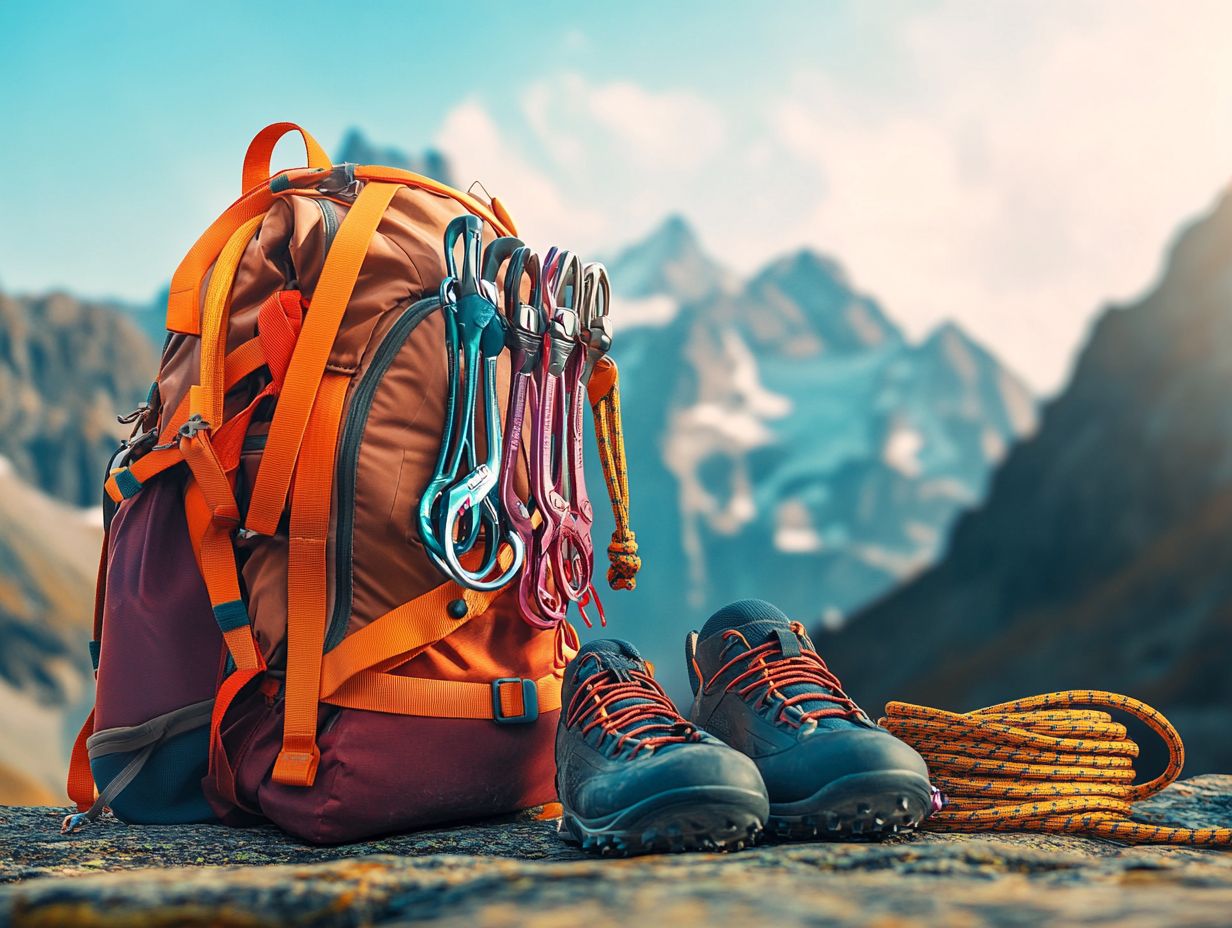
- Choose versatile, lightweight climbing gear for easy travel. Grab the Metolius Roll Up Stick Clip Kit for quick gear testing.
- Invest in high-quality gear and maintain it properly for longevity.
- Pack a first aid kit and learn basic rescue techniques for emergencies.
1. Climbing Shoes
Climbing shoes are vital, crafted to elevate your performance by delivering optimal grip, support, and comfort for various techniques. The weight and fit of these shoes are critical; they must balance durability and lightweight design, ensuring you perform at your best on challenging routes.
Brands like Black Diamond and Wild Country provide innovative options tailored to different climbing categories, including the best climbing gear for multi-pitch routes, helping you pick the ideal pair for your adventures.
Understanding different climbing shoes is key to your success! You ll find options like neutral, moderate, and aggressive designs, each serving distinct functions based on your climbing style. Materials such as synthetic fabrics and leather affect breathability and stretch, while features like rubber soles enhance friction on rocky surfaces. Choosing the right shoe maximizes your performance and plays a vital role in your safety. A properly fitted shoe can prevent slips and improve your foothold.
If you’re venturing into sport climbing or bouldering, high-performance models are highly recommended. Casual climbers will find comfort-fit shoes more suitable for multi-pitch climbs. When heading to destinations like Yosemite or the Red River Gorge, having a variety of shoe types prepares you for diverse conditions.
2. Chalk Bag
A chalk bag is an essential accessory for climbers. It helps maintain optimal grip and performance by keeping your hands dry during ascents. This vital piece of gear enhances your hold on various surfaces and boosts your confidence as you tackle challenging routes.
With a variety of shapes and sizes available, chalk bags cater to different climbing styles ranging from classic cylindrical designs to unique, eye-catching features that reflect your personal taste. Many bags come equipped with adjustable waist straps and extra pockets for convenience, making them easy to use while climbing.
Selecting the right chalk bag directly influences your climbing safety and performance. Highly regarded options like the Black Diamond Mojo Chalk Bag and Petzl OUIZI Chalk Bag stand out for their durability and functionality, giving you the confidence to push your limits.
3. Harness
A climbing harness is essential for your safety. It offers crucial support as you tackle challenging routes and ensures a secure connection to the belay device.
You ll find various types of harnesses tailored to specific climbing activities, whether you re into sport climbing, traditional climbing, or alpine climbing. Sport climbing harnesses often use lighter materials and a streamlined design, maximizing your mobility. Trad harnesses typically have extra padding, providing comfort during extended climbs.
When choosing the right harness, consider adjustable leg loops and a secure waist belt to accommodate various clothing layers. Your personal safety preferences and fit play a pivotal role. A well-fitted harness significantly enhances your performance and freedom of movement, making your climbing experience all the more enjoyable.
4. Belay Device
A belay device is a crucial piece of climbing gear that keeps you safe by controlling the rope during climbs. It allows you to belay securely and respond effectively.
These devices come in various types, each designed for specific climbing scenarios. Take the Petzl Grigri, for example a favorite among climbers. It features automatic braking, which enhances safety by stopping the rope in case of a fall. On the other hand, tube-style devices offer a minimalist approach, providing smooth and effective belaying for both top-rope and lead climbing (where you lead with the rope attached to protection points).
Picking the right belay device can change the game for you! The efficiency of rope control directly impacts your ability to respond to sudden falls or shifts in weight. Make this decision with careful consideration!
5. Quickdraws
Quickdraws are essential for your climbing protection. They securely connect your rope to anchors while allowing you the flexibility to move as you ascend.
These compact tools consist of two carabiners linked by a robust sewn sling, designed for swift attachment and removal. The materials you choose, whether aluminum or stainless steel, impact the weight and strength of the quickdraw both crucial for climbing.
Opting for lightweight options, like the Raven Quickdraw from Ocun, minimizes the load you carry without compromising on durability. The right quickdraw not only enhances your safety by preventing falls but also boosts your performance by allowing smooth and efficient clipping. This leads to a more confident climbing experience, so you can focus on conquering those heights!
6. Rope
Climbing ropes are essential for your safety, providing vital support and security as you ascend and descend.
Understanding the various types of climbing ropes can elevate your climbing experience. Each rope is tailored for specific activities, whether you re tackling rock climbing, mountaineering, or rappelling. Important factors to consider include rope weight, which affects portability, and durability, particularly if you navigate rugged terrains frequently.
Safety ratings are also paramount; they indicate the rope’s ability to withstand falls and endure harsh conditions. By assessing these characteristics in relation to your climbing style, you can make informed decisions that match your unique needs.
7. Climbing Helmet
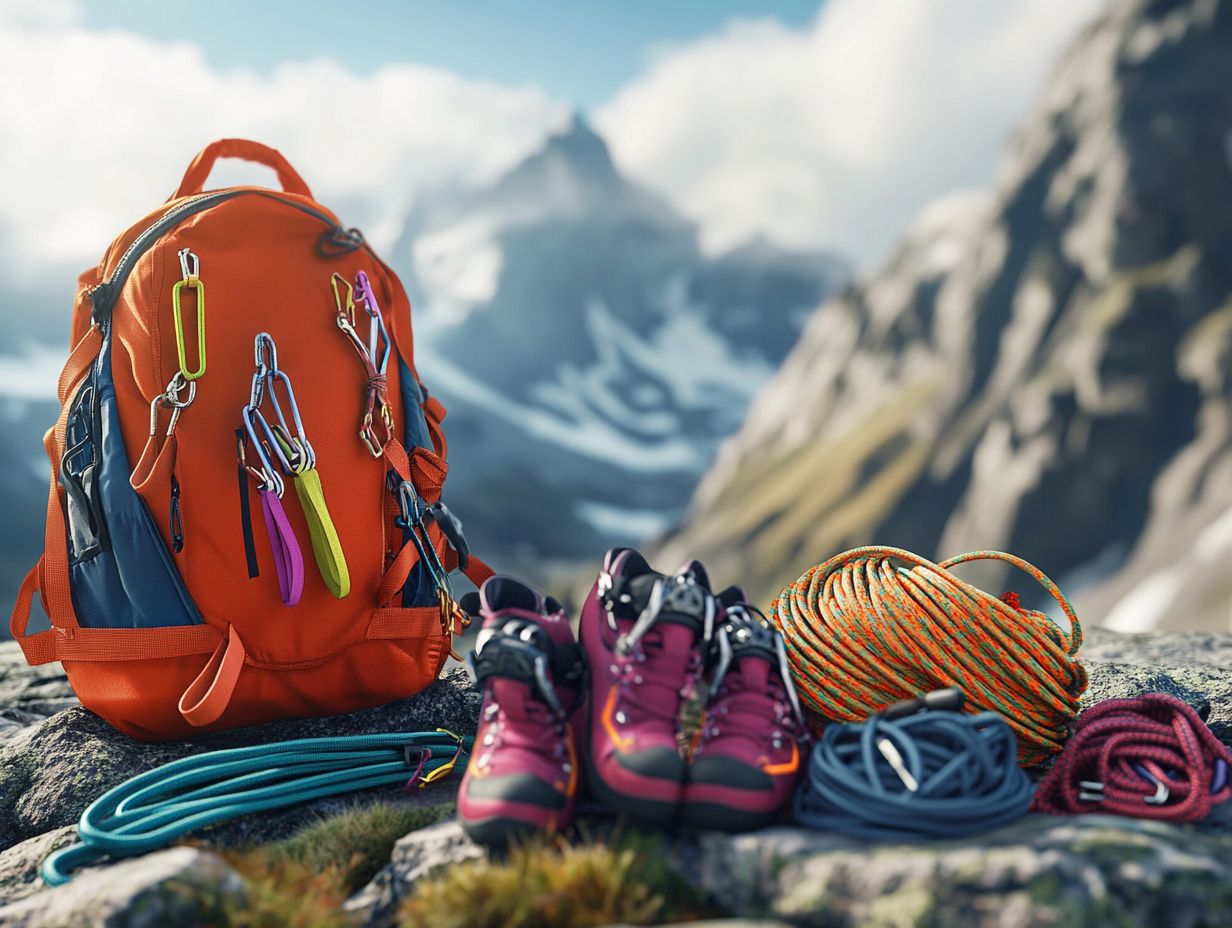
A climbing helmet is an essential part of your climbing safety gear. It protects you from falling debris and impacts during your adventurous pursuits.
Selecting the right helmet significantly enhances your safety while ensuring comfort during lengthy ascents. With options like hybrid, hard-shell, and foam helmets, each type offers unique advantages tailored to different climbing styles and environments.
When making your choice, consider critical factors such as fit, weight, and ventilation. A well-fitted helmet should remain securely in place without causing discomfort. Today’s helmets feature innovative safety designs like adjustable chin straps, impact-resistant materials, and integrated headlamps, combining practicality with style for the contemporary climber.
Don t leave your safety to chance choose the right gear today!
8. Carabiners
Carabiners are essential tools in your climbing arsenal. They serve as the vital link between various pieces of equipment while significantly enhancing your overall safety and efficiency on the rock face.
These versatile tools come in an array of shapes, sizes, and designs, each tailored for specific applications. For example, locking carabiners are essential for securing your rope, providing that extra layer of safety. Non-locking versions make it easy to grab your gear quickly when every second counts.
Don t overlook the specialty types, like the pear-shaped carabiner, which is a go-to for aid climbing, or the compact variants perfect for sport climbing.
Among the standout options on the market, the Fixe Hardware Alien has gained a reputation for its exceptional performance and versatility, making it a favorite among climbers.
When choosing the right carabiner for your needs, consider your climbing style and the specific requirements of your activity. Think about the type of gear you ll be using. This approach keeps you safe and lets you focus on the fun of climbing!
9. Climbing Backpack
A climbing backpack is essential for carrying all your necessary outdoor gear. It seamlessly blends convenience and accessibility for your climbing adventures.
When selecting the perfect climbing backpack, you’ll want to consider several key features that enhance usability and comfort. Size plays a crucial role. Choose a pack that fits the duration of your trip to achieve an ideal balance of weight and space.
Compartments are equally important for keeping your gear organized, allowing quick access to essentials like equipment, snacks, and hydration without the hassle of digging through the entire pack. Don t underestimate comfort; padded straps and breathable back panels can significantly elevate your overall climbing experience.
Implementing an efficient packing strategy that prioritizes weight distribution and easy access to essentials will set the stage for a successful and enjoyable climbing expedition.
10. Climbing Pants
Climbing pants are crafted with your needs in mind. They are designed for optimal movement to give you the flexibility and durability required to conquer those challenging routes.
They feature reinforced knees and strategically placed pockets. These elements not only enhance functionality but also reduce wear and tear during intense climbs.
Constructed from a mix of materials like nylon, spandex, and even cotton blends, these pants provide the breathability you desire while allowing for a full range of motion. You ll find styles that range from relaxed fits to more tapered cuts, catering to your personal preferences and body type.
The right pair can make all the difference on your climb! A well-chosen pair strikes the perfect balance between comfort and performance, enabling you to concentrate on your ascent rather than your gear.
11. Climbing Shirt
A climbing shirt is essential for ensuring your comfort and breathability during those intense climbing sessions. It’s a vital part of your climbing essentials.
Selecting the right climbing shirt can significantly boost your performance. It allows you to concentrate on the ascent rather than any nagging discomfort. Many brands offer options crafted from synthetic materials that expertly wick away moisture and dry quickly perfect for those warm weather climbs.
For cooler days, look for shirts made with insulated fabrics that offer added warmth without compromising flexibility. When you’re choosing a shirt, consider factors like humidity levels, temperature, and the specific type of climbing you plan to undertake.
A well-fitting shirt grants you maximum freedom of movement. Features like pockets and ventilation can prove invaluable during extended climbs, especially in various climbing destinations.
12. Climbing Gloves
Stay safe and perform better with climbing gloves. They give you grip and protection, especially in challenging environments.
These gloves protect your hands from cuts and scrapes. They also offer insulation from the cold, which is a game-changer on long climbs. The right pair can enhance your adherence to the rock, granting you improved control and maneuverability.
You’ll find a variety of climbing gloves available, from lightweight models perfect for summer to heavier options designed for colder climbs. If you’re serious about your climbing adventures, consider checking out the best climbing gear for wall climbers from brands like Black Diamond, Petzl, and Mammut. They offer some of the finest choices on the market, expertly blending durable materials with comfortable designs tailored to meet your specific climbing needs.
13. Climbing Tape
Climbing tape is a must-have! Protect your fingers and hands from injury while enhancing safety on your adventures.
This tape reduces the risk of cuts, abrasions, and blisters that can arise during challenging ascents. You can easily wrap it around injured fingers or reinforce weak joints, allowing you to continue climbing with renewed confidence.
When choosing the right climbing tape, consider factors like adhesive strength and elasticity. Tailor your selection to specific activities, whether you re bouldering, sport climbing, or tackling alpine ascents. A quality tape strikes the right balance between durability and flexibility, allowing for smooth movements while providing the support you need.
14. Headlamp
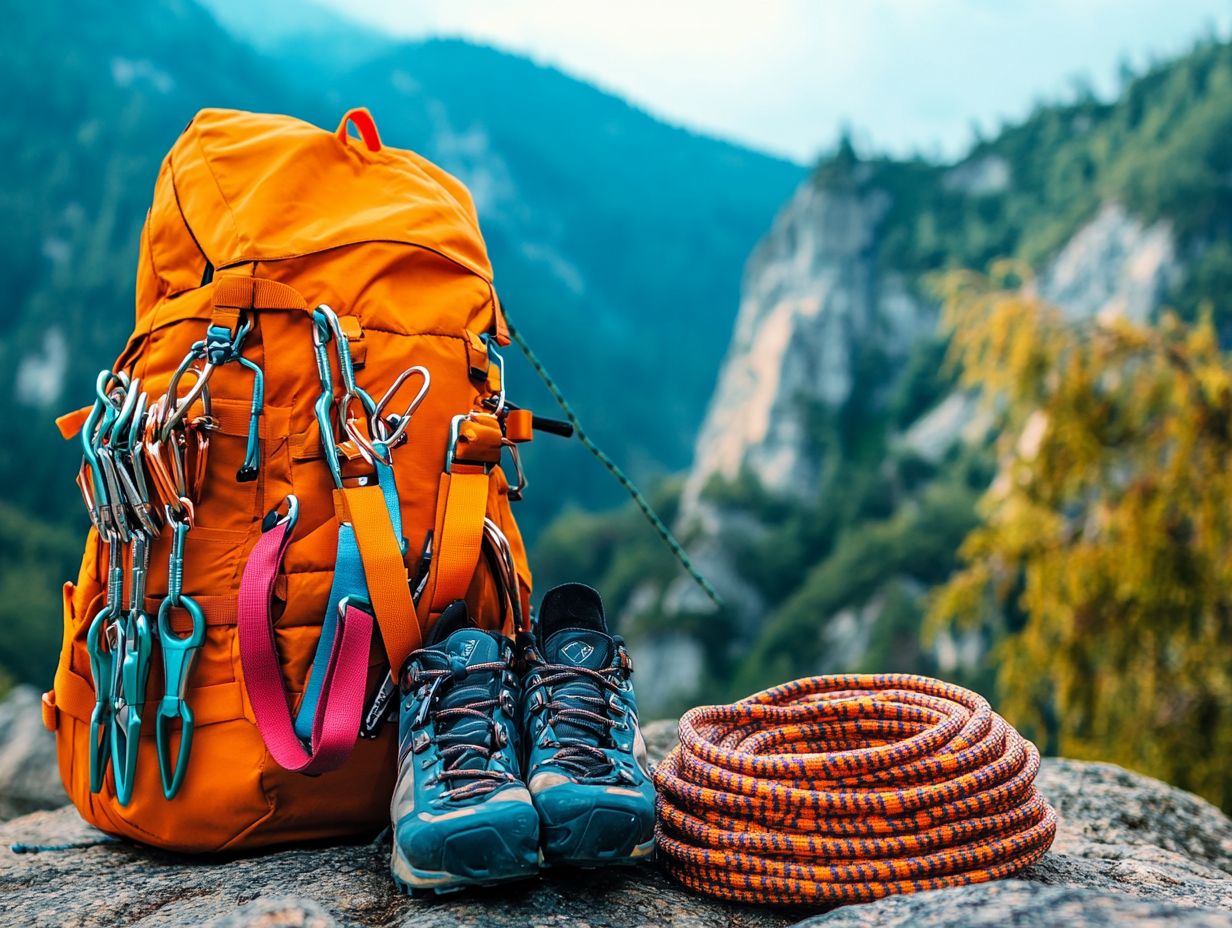
A headlamp is your best friend in low-light climbing. It frees your hands and lights your path.
With various options available, you can choose models tailored to your needs whether you’re an ultralight backpacker seeking a compact design or a professional climber in need of a robust, heavy-duty version. Key features like adjustable brightness levels, red-light modes to maintain your night vision, and waterproof ratings are crucial for enhancing safety during your climbing adventures.
When selecting a headlamp, consider battery life, weight, and comfort. These factors significantly influence your overall experience on the climb. Choosing a model that strikes the perfect balance between brightness and portability will ensure you have reliable illumination to navigate challenging terrains with confidence.
15. First Aid Kit
Don’t hit the trail without a first aid kit! It’s crucial for your safety during outdoor escapades.
A well-stocked first aid kit can make the difference between a minor mishap and effectively managing a significant injury. You ll typically want to include items such as:
- Adhesive bandages
- Antiseptic wipes
- Gauze pads
- Adhesive tape
- Elastic bandages
It s vital to be equipped not only with basic supplies but also with specialized items that address the unique risks of climbing, such as splints for fractures or blister care essentials.
Being proactive about potential injuries means recognizing that accidents can occur. Having a solid plan and a clear understanding of how to use each component of your kit can greatly enhance your safety and confidence as you tackle those challenging routes.
What Are the Essential Gear for Traveling Climbers?
Traveling climbers like you need gear that is a good mix of functionality and portability. This ensures a safe and enjoyable climbing experience no matter where your journey takes you, especially when using the Outside+ app for gear recommendations.
When venturing into diverse terrains, consider lightweight harnesses for comfort and compact racks that simplify gear organization. Selecting versatile climbing shoes that can handle various surfaces enhances your performance on different rock types. A durable yet lightweight backpack holds all your gear while helping you maintain agility on the trail. For those interested in indoor climbing, don’t forget to check out the essential gear for indoor climbing.
Each climbing destination presents unique challenges. Understanding the specific environmental conditions aids in selecting the right gear. Investing in multi-functional tools boosts efficiency while keeping your pack weight down—a crucial factor for climbers who prioritize mobility and ease during their adventures. For more tips, check out this guide on how to pack your climbing gear efficiently.
How Can One Pack Efficiently for Climbing Trips?
Packing efficiently for your climbing trips is essential. It ensures you have all the necessary gear while keeping your load light and your equipment readily accessible.
To achieve this, think strategically about how to pack your gear and what you’ll need at different stages of your climb. Start by compartmentalizing your backpack, designating sections for climbing hardware, first aid supplies, and personal items. Additionally, make sure to include the top climbing gear for rock climbers to enhance your safety and performance on the route.
By prioritizing essentials, especially quick-access items for the base of the climb, you can dramatically improve how prepared you feel as you ascend. Opt for climbing backpacks with external attachment points and pockets; this way, you can organize your climbing gear effectively and focus on your adventure ahead without constantly digging through your pack.
What Are Some Tips for Choosing the Right Climbing Gear?
Choosing the right climbing gear is crucial for your safety and performance. This is particularly important across different climbing categories and techniques, which can enhance your climbing experiences.
Whether you’re drawn to bouldering, sport climbing, or tackling traditional multi-pitch routes, understanding your personal needs along with the right gear can be a game changer. For example, bouldering typically requires less equipment, so focus on crash pads and climbing shoes. In contrast, sport climbing often calls for harnesses, quickdraws, and ropes. For those looking to enhance their gear selection, check out the essential climbing gear for sport climbers.
As you assess your options, remember to consider the fit, weight, and durability of the gear. Keep an eye on trusted brands like Black Diamond and Petzl. Always prioritize safety features, such as locking carabiners and dynamic ropes ropes that stretch to absorb falls because these elements enhance your performance and grant you peace of mind while scaling the rock face. For those looking to invest wisely, check out the best climbing gear for alpine climbs.
How Can One Maintain and Care for Their Climbing Gear?
Proper maintenance and care of your climbing gear are vital for its longevity and your safety during climbs, effectively preventing equipment failure at critical moments.
Make it a habit to clean your gear after each use, removing dirt and debris that can diminish its performance over time. Inspect your gear for signs of wear like frayed ropes or damaged carabiners and make this a routine part of your preparation before every outing.
Store your gear in a cool, dry place away from direct sunlight to maintain its integrity. Establish a schedule for gear testing and replacements; for example, ropes typically need replacing every 3 to 5 years, depending on how often you use them.
By following these guidelines, you enhance your safety and prolong the life of your cherished equipment. Get ready for your next adventure with the right gear!
What Are Some Common Mistakes to Avoid When Packing for Climbing Trips?
Avoiding common mistakes when packing for climbing trips is essential for ensuring a successful adventure. This allows you to have the right gear without unnecessary burdens.
Take the time to evaluate the essential items needed for your climb. Focus on what truly matters and eliminate excess weight that could impact your performance and safety. If you pack poorly, you might forget something important, which not only hampers your climbing experience but may also place you in precarious situations. For beginners, choosing the right climbing gear is crucial to ensure safety and enjoyment.
Prioritizing essential climbing gear like harnesses, helmets, and ropes is crucial for staying safe on your adventure! Be mindful of common packing errors, such as ensuring even weight distribution and considering weather conditions. Additionally, don’t forget to include top 10 must-have climbing gear accessories to significantly increase your chances of a rewarding and safe journey.
Frequently Asked Questions
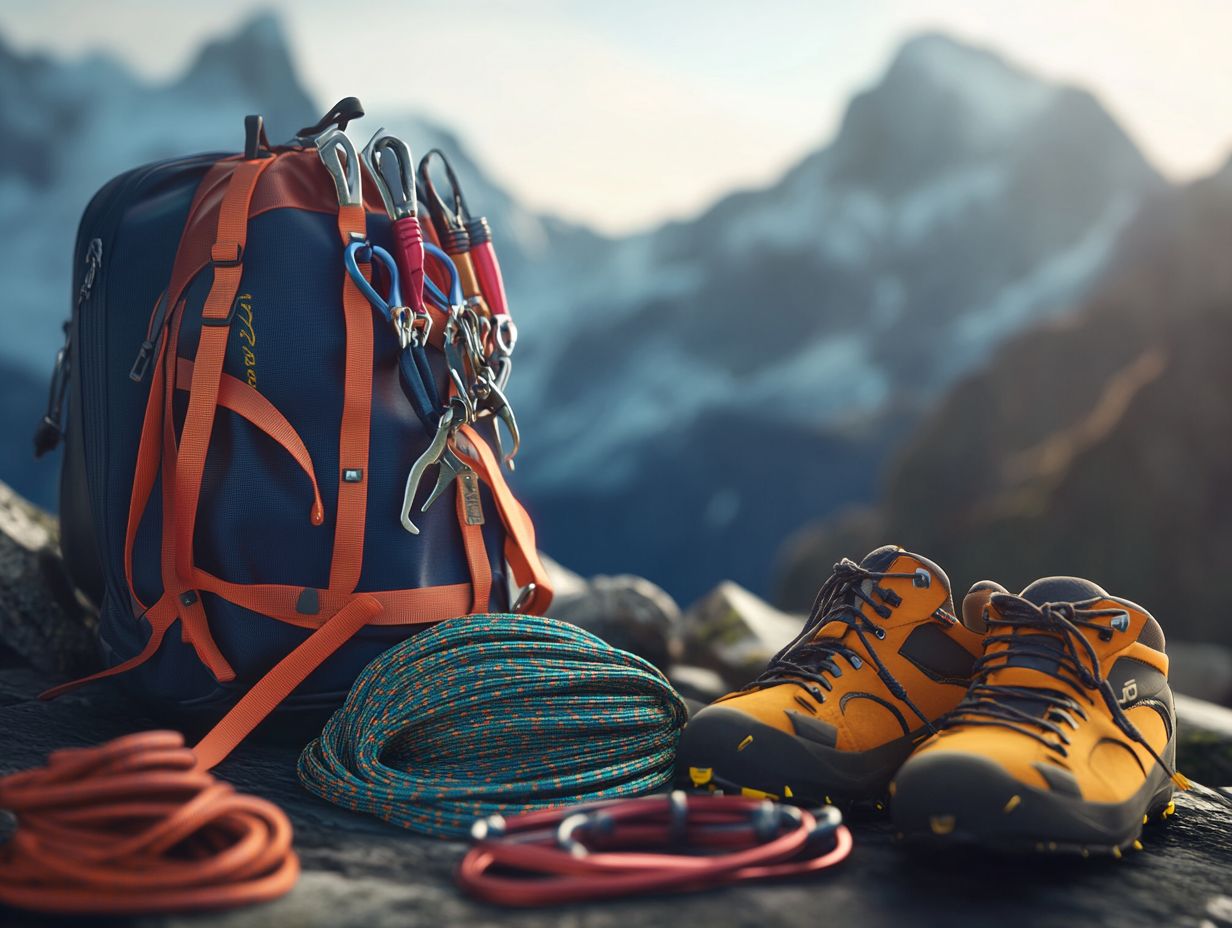
What are the must-have items for traveling climbers?
The best climbing gear for traveling climbers includes a lightweight harness, a portable crash pad, a compact rope, quickdraws, and a sturdy backpack to carry everything.
What type of harness is best for traveling climbers?
A harness with minimal padding and a lightweight design is ideal for traveling climbers. Look for one that is comfortable enough for long routes, but also easy to pack and carry.
Do I need to bring a crash pad while traveling for climbing?
Yes, a portable crash pad is essential for protecting yourself from falls while bouldering outdoors. It can also double as a comfortable seat for resting in between climbs.
How long should my climbing rope be for traveling?
A compact rope between 60-70 meters is recommended for traveling climbers. This length is versatile enough for a variety of climbing routes and can also fit in most luggage.
What should I look for in quickdraws for traveling climbers?
For traveling climbers, lightweight quickdraws with a variety of lengths are ideal. Look for ones with a durable yet lightweight construction and a convenient clipping mechanism.
Can I use a regular backpack for carrying my climbing gear while traveling?
A regular backpack can be used to carry your climbing gear while traveling, but it may not be the most comfortable option. Look for a backpack specifically designed for climbing gear, with padded straps and compartments for organization.

